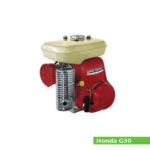
The Honda G30 engine has a single cylinder, L-head design with two valves and heavy-duty recoil starter. This engine used horizontal type carburetor with butterfly valve, high-voltage ignition system, splash type lubricating system and forced-air cooling system. The G30 is equipped with 4.5 L fuel tank.
The G30 engine produced 4.0 PS (2.9 kW; 4.0 HP) of peak horsepower and 3.0 PS (2.2 kW; 3.0 HP) at 3,400 rpm of rated output power.
General information
| Engine Specifications | |
| Engine model | G30 |
| Engine type | 4-stroke, L-head, single-cylinder |
| Displacement | 132 cm3, (8.1 cu·in) |
| Max. horsepower | 4.0 PS (2.9 kW; 4.0 HP) |
| Max. torque | – |
| Cooling system | Forced air |
| Lubricating system | Splash type |
| Ignition system | High-voltage ignition |
| Fuel system | Horizontal type carburetor with butterfly valve |
| Fuel tank capacity | 4.5 L (1.19 US. gal. 0.99 Imp. gal.) |
| Fuel used | Unleaded gasoline (octane number 86 or higher) |
| Starting system | Recoil starter |
| Stoping system | Ignition primary circuit ground |
| PTO shaft rotation | Counterclockwise (from PTO shaft side) |
Service Data
| Oil system | |
| Lubrication system: | Splash type |
| Oil type: | SAE 20 or 30 |
| Recommended oil: | Honda 4-stroke or an equivalent |
| Oil capacity: | 0.57 L (0.6 US. qt, 0.5 Imp. qt.) |
| Fuel system | |
| Type: | Horizontal type carburetor with butterfly valve |
| Ignition system | |
| Type: | High-voltage ignition |
| Spark plug: | NGK: C-6HB |
| Spark plug gap: | 0.6-0.7 mm (0.0236-0.0276 in) |
 Author:
Author:
Be the first to comment